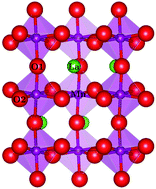Defects in orthorhombic LaMnO3 – ionic versus electronic compensation
Abstract
The ionic and electronic conductivity of orthorhombic LaMnO3 can be modified by introducing lower valence dopants at both the La and Mn sites. Alkaline earth doped perovskites, such as LaMnO3, have a variety of applications in catalysis, for nitrogen storage and reduction, and oxidation of volatile organic compounds, and as the oxygen electrode in solid oxide fuel cells. Here, we investigate doping with the divalent alkaline earth metals Mg, Ca, Sr and Ba, and the charge compensation mechanism. The energies of formation of isolated defects and clustered pairs were investigated at both La and Mn sites to establish the most probable site at which they will be introduced. The charge compensation mechanism for the introduction of alkaline earth dopants was examined by considering both ionic (formation of an oxygen vacancy for every two alkaline earth dopants introduced) and electronic compensation (a hole localised at the Mn site for each dopant introduced). Larger cations (Ca, Sr and Ba) were found to have lower defect formation energies when introduced at the La site, while the smaller Mg defect had lower formation energies when introduced to the Mn site. For all defects introduced, electronic compensation for the defect was found to be more energetically favourable, which will result in improved electronic conductivity of the material.



 Please wait while we load your content...
Please wait while we load your content...